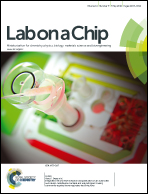Wettability patterning for high-rate, pumpless fluid transport on open, non-planar microfluidic platforms†
Abstract
Surface tension driven transport of liquids on open substrates offers an enabling tool for open micro total analysis systems that are becoming increasingly popular for low-cost biomedical diagnostic devices. The present study uses a facile wettability patterning method to produce open microfluidic tracks that – due to their shape, surface texture and chemistry – are capable of transporting a wide range of liquid volumes (~1–500 μL) on-chip, overcoming viscous and other opposing forces (e.g., gravity) at the pertinent length scales. Small volumes are handled as individual droplets, while larger volumes require repeated droplet transport. The concept is developed and demonstrated with coatings based on TiO2 filler particles, which, when present in adequate (~80 wt.%) quantities within a hydrophobic fluoroacrylic polymer matrix, form composites that are intrinsically superhydrophobic. Such composite coatings become superhydrophilic upon exposure to UV light (390 nm). A commercial laser printer-based photo-masking approach is used on the coating for spatially selective wettability conversion from superhydrophobic to superhydrophilic. Carefully designed wedge-patterned surface tension confined tracks on the open-air devices move liquid on them without power input, even when acting against gravity. Simple designs of wettability patterning are used on versatile substrates (e.g., metals, polymers, paper) to demonstrate complex droplet handling tasks, e.g., merging, splitting and metered dispensing, some of which occur in 3-D geometries. Fluid transport rates of up to 350 μL s−1 are attained. Applicability of the design on metal substrates allows these devices to be used also for other microscale engineering applications, e.g., water management in fuel cells.


 Please wait while we load your content...
Please wait while we load your content...